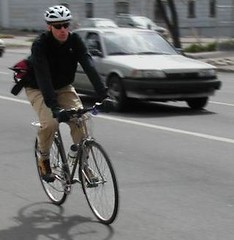 Dan Grunig, Executive Director of Bicycle Colorado, bicycles through the streets of Denver, Colorado.
Dan Grunig, Executive Director of Bicycle Colorado, bicycles through the streets of Denver, Colorado. Under Dan's direction, Bicycle Colorado has grown to have a four-person staff with a $300,000 budget. Dan has a graduate degee from the non-profit business program at the University of Wisconsin. To successfully allow a bicycle advocacy organization to thrive, Dan tells me that it's necessary to understand fundraising, finance, management, marketing, and boards.
Beyond that, however, Dan is motivated by the mission of Bicycle Colorado. To that end, Bicycle Colorado works with local groups in Colorado to get a group connected and rolling. Many groups have started this way in Douglas County, Fort Collins, Grand Junction, Winter Park, Jefferson County and elsewhere.
I asked Dan what people can do in their cities to promote cycling. He answered,
One of the most often overlooked (and underrated) is being an ambassador for bicycling every time you ride. Knowing and following the rules of the road and trail project a positive image of bicycling to the public and our opponents.
People promoting rights for vehicles other than bicycles love to point to examples of discourteous or dangerous behavior by bicyclists. We have total control to nullify this argument by simply following the rules. By following the rules you are far less likely to be in a crash and in the rare chance that you are, you will have better protection in the legal system.
The other is way to make a difference is definitely cliché, but our governmental decision making process is dominated by people who show up. It is much easier for a transportation official to overlook the rights of bicyclists when there is no bicyclist in the room.
Transportation decisions are happening every day in every community in Colorado. Many of the decisions made today won’t be implemented for five to thirty years so the sooner we “show up,” the sooner things start getting better.
I know coming out of college, politics was a turn off for me and I felt like I couldn’t have any influence on the system. What I have learned since is exactly opposite! I want bicyclists to know we most definitely can have tremendous influence and the system can work in our favor. But it won’t happen on its own. We each need to add just a little time, energy, and money and the gains will be substantial.
So my advice is to get connected with your local advocacy group and send a check to each of your local, state, and national bicycle advocacy groups. For less than the cost of a tank of gas, you can add horsepower to the bicycle movement.
What if a city has an active and effective advocacy group? Should others try to be involved?
I would challenge an uninvolved bicyclist to ask themselves some important questions: Are you pleased with how bicyclists are treated in your community? Are there bike lanes and paths along your favorite routes? Are motorists respectful and courteous? Do you feel safe on your bike? Is your business or school accommodating to bicyclists? Do local businesses welcome customers who ride bikes? Is your community reducing pollution? Are residents healthy and active?
A community with a fairly active bicycle advocacy community is probably making some nice progress, but transportation change is slow by nature. The more people we have working for improvements, the sooner they will happen. Sitting on the sidelines and letting other people do the work and pay the bills won’t produce substantial change in the near future.
We need to be impatient. We need to understand the time to make time is now.
I believe the way to get involved is through your local bicycle advocacy group. By coordinating efforts and working on specific campaigns, we can accomplish tremendous things.
What about the area where there is no cycling advocacy? How can the cyclist begin to make changes?
I think this probably the most exciting scenario a bicyclist can be in. Since nothing is happening right now, this is a situation where they have potential to make tremendous gains.
The first thing to understand is that you are not alone. Hundreds of bicycle advocacy groups across the nation have started in the exact same situation. Thunderhead Alliance is the collection of those experiences. Getting plugged into their knowledge base and training system is a “fast forward” to success.
My message is that it takes a group to really affect change. Building an organization builds power and credibility. It also provides more people help share the load.
Bicycle Colorado’s mission keeps our efforts focused on statewide decisions and programs. Our intention is to improve the actions of the state’s transportation department so that communities who look to the state for leadership will also adopt bicycle friendly policies.
The real power at the local level comes from the community’s citizens. A group made up of outsiders doesn’t carry as much weight as one made up of people who live there. Bicyclists in individual communities have to take the first step. They have to stand up and begin asking why bicyclists’ rights are being pushed aside. When they begin to take action, everything changes.

No comments:
Post a Comment